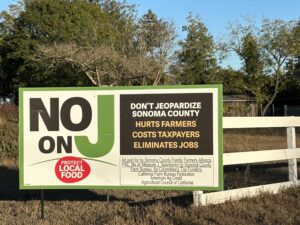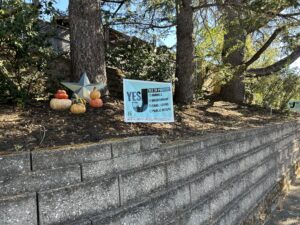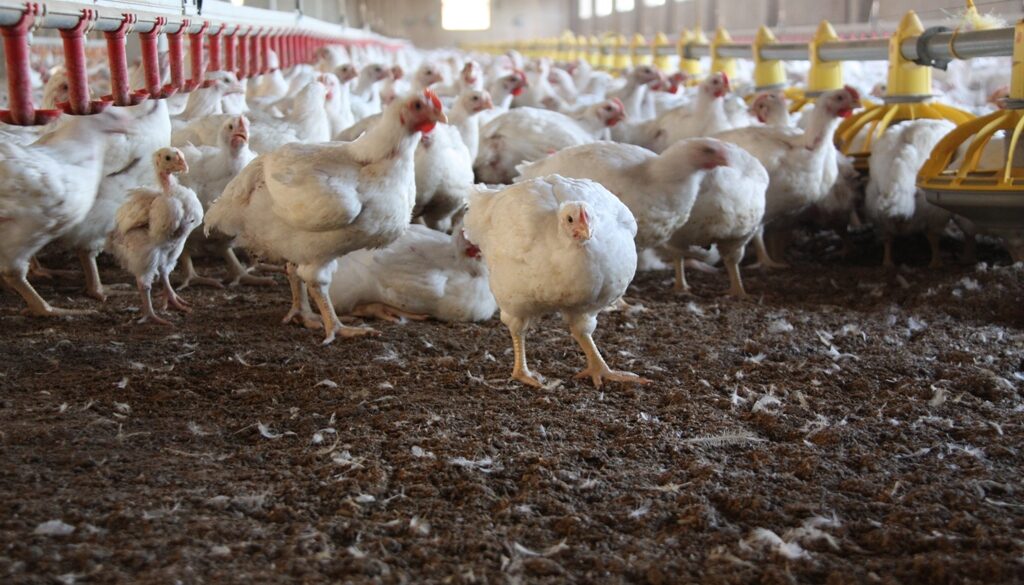Proposed factory farm ban divides California county
When voters head to the polls on Tuesday to decide the next US president, residents of Sonoma County, California, will be asked to decide another contentious issue – they will be voting on a measure that would make their county the first in the nation to ban factory farms.
Measure J would prohibit farm operations that meet the US Environmental Protection Agency (EPA)’s definition of a concentrated animal feeding operation (CAFO), requiring them to either close or downsize within three years. The measure would also prevent new CAFOs from coming into the county.
Proponents say that CAFOs, where large numbers of animals are crowded together generating massive amounts of manure, are “major polluters” that pose a threat to wildlife and “vital watersheds” and present a “serious risk to public health” by providing a breeding ground for disease and creating other hazards. They cite one Sonoma County poultry operation with more than 500,000 birds as well as “documented criminal animal cruelty” at some CAFOs.
The measure appears to have only a slim chance of passing, facing staunch opposition from powerful farming organizations as well as business groups and even sustainability groups. But backers of the measure say their effort contributes to a groundswell of support for action against CAFOs.
In July, a state court in Michigan ruled that state regulators could take stronger actions to manage manure waste from CAFOs there, and in June 2023, Oregon passed a bill to tighten CAFO permitting to help mitigate water pollution. Calls for moratoriums on new CAFOs have been heard in recent years by legislatures in Iowa, Missouri, Minnesota, and Wisconsin.
“There’s been a lot of attempts, but there’s nothing yet that has been an actual vote among the people on prohibiting factory farms,” said Cassie King, an organizer with the activist group Direct Action Everywhere and the Yes on J campaign. “I think there’s a latent desire across the country to stop factory farming. This measure would provide not only a blueprint but also the inspiration that’s needed to kick more action into gear.”
Measure J is modeled on the Farm System Reform Act, said King, which was introduced in 2023 by US Sen. Cory Booker but has yet to move forward. The bill proposes phasing out CAFOs on a national level by 2041.
Measure J supporters state that only 21 of the more than 700 animal farms in the county would be affected if it passes.
But opponents, including the Sonoma County Farm Bureau, maintain the measure will have a number of negative ripple effects, including jeopardizing the existence of even small farming operations and reducing the availability of local meat, dairy and eggs.
Dayna Ghiardelli, executive director of the Sonoma County Farm Bureau, said the measure doesn’t account for whether a farm is organic or employs other positive practices and that there is no way to know how many farms would be directly affected by Measure J because the county doesn’t know how many farms meet the EPA’s definition of a CAFO.

The measure is a step towards eradicating animal agriculture altogether, Ghiardelli said, and the county farm bureau has led a $1.5 million campaign against it.
Opponents of Measure J have pointed to a University of California extension economic analysis commissioned by the Sonoma County Board of Supervisors, which reported a potential $381 million loss to the local economy if the measure passes. Supporters say the analysis is flawed, relying on incorrect assumptions.
Debate over the issue has roiled the county, including even threats of violence. Last month, the Sonoma Sheriff’s Office said it was looking into a threatened mass shooting at the farm bureau offices.
“An assault on the environment”
CAFOs are well known in environmental circles as major polluters, leaching huge quantities of nitrate- and pathogen-ridden animal manure into waterways and emitting harmful particulate matter that puts nearby communities at risk.
But while these operations are regulated by the EPA under the Clean Water Act, federal regulators don’t track the locations and sizes of CAFOs, according to research by the Natural Resources Defense Council.
By confining many animals in close quarters under unsanitary conditions, CAFOs can enable the spread of avian (bird) flu, which shook Sonoma County last winter, and can contribute to the emergence of novel viruses.
Factory farms can also raise risks for the contamination of fruits and vegetables with harmful pathogens when bacteria in animal manure end up in waterways used to water food crops, potentially causing incidents like a recent McDonald’s E.coli outbreak that killed one person and sickened others.
The Centers for Disease Control and Prevention and the Food and Drug Administration reported this week that onions supplied by a California produce company were likely to blame for the outbreak. In California, 4,000 acres of onion crops were planted within one mile of a CAFO in 2022, according to an analysis by the Environmental Working Group.
While Sonoma County is not among California’s top 10 counties for agricultural sales, supporters of Measure J says their community has many factory farm-related problems. They point to EPA data showing county watersheds are impaired with bacteria and other microbes that they say fit the profile of animal waste from CAFOs.
In 2017, high levels of nitrates linked to dairy farms were found in one Sonoma County community’s well water, forcing business owners to truck in water from another city. Nitrates are linked to an array of health problems, including an increased risk for colon cancer, and birth defects.
“We have an assault on the environment in Sonoma County and CAFOs are one of the primary problems,” said Patty Clary, Executive Director of the group Californians for Alternatives to Toxics. “What we have in the streams are pollutants that indicate domesticated animal discharges,” said Clary. “We have phosphates and nitrogen. There’s really no other polluter indicated with those types of discharges and those types of pollutants in the water.”
Californians for Alternatives to Toxics sued the local 373-acre Reichardt Duck Farm in 2022, alleging that for 65 years the facility has discharged stormwater contaminated with duck feces, nitrates, phosphates, and other chemicals into a nearby creek that drains into major waterways. A settlement last year required the farm to pay over $300,000, including a payment to a foundation dedicated to improving water quality in the impacted watersheds.

Last October, another local farm, Mulas Dairy, closed after reaching a settlement with the California Sportfishing Protection Alliance for also allegedly polluting local watersheds.
Ghirardelli said it is “simply not true” that CAFOs are the cause of the county’s impaired watersheds.
“I’m not saying [the water pollution] is not from animals, but there’s a lot of different animals here, including wildlife,” she said, adding that human waste from septic systems are major contributors to local water pollution.
“Out of business”
Operators at area agricultural operations said they believe Measure J would make it impossible for some dairies and egg farms to continue operating, and they take issue with the focus on size, saying there are other factors that determine an animal agriculture operation’s impact on the environment.
Joseph Button, vice president of the Straus Family Creamery, which sources its milk from 13 organic dairies, said downsizing is not a good option for some organic farms that require a certain herd size to manage pasture growth and mitigate against wildfire risk.
Mike Weber, owner of a major egg production operation in the county, said he would be forced to cut his workforce if he had to reduce the numbers of hens laying eggs. His main chicken ranch usually houses around 500,000 birds, he said.
According to the Yes on J website, he would be required to downsize to less than 82,000 birds total if the measure passes. Weber’s operation would also struggle to compete with larger farms from other counties and those that ship eggs into California from out of state, he said.
“We are a very small producer on the national scale and [Measure J] is designed to put us out of business,” said Weber.
Weber said his poultry farm is the first in the state to install manure dryers, which help cut greenhouse gas emissions, and the first in the state to start using a pellet mill that turns the dry chicken manure into pellets used as organic fertilizer.
“Those sorts of steps that we take here, they get copied and that’s what we want to celebrate,” said Weber. “We don’t want to be shut down because we’ve made investments to do things right.”
(Featured image by jlastras via Wikimedia Commons CC BY-SA 2.0.)
 EWG
EWG


